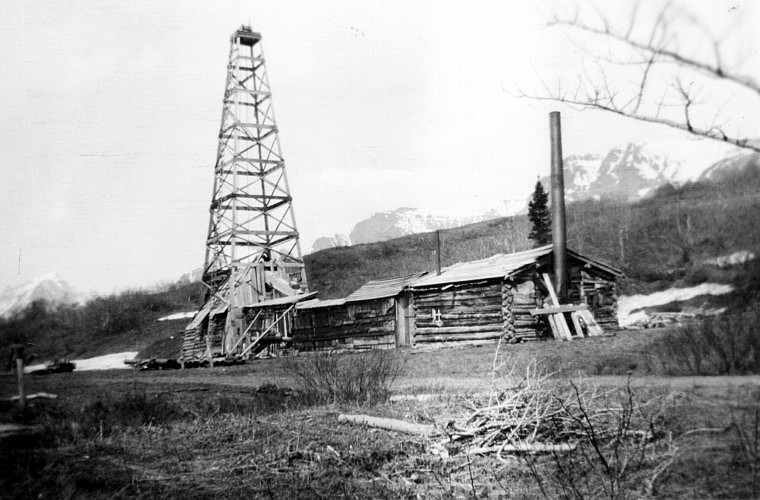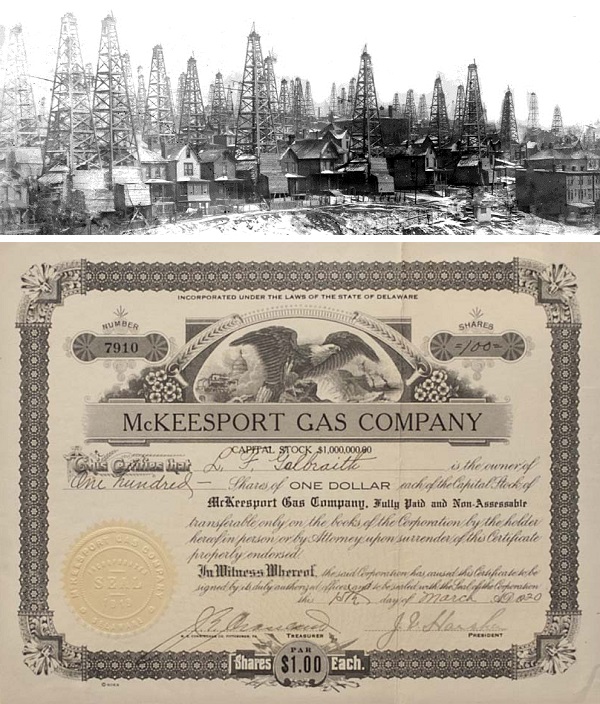by Bruce Wells | Feb 29, 2024 | Petroleum Companies
Although successful oil wells had been drilled as early as 1901, oil fever arrived in Montana with the October 1915 discovery of the Elk Basin oilfield in Carbon County.
More discoveries came at the Cat Creek oilfield in 1920 and in the Kevin-Sunburst oilfield of 1922, both of which motivated businessmen in Miles City to form the Montana Bell Oil & Gas Company. They filed to do business in the state on March 8, 1924, but their timing was terrible.

Montana’s first oil well was drilled in 1901 in the Kintla Lake area that’s now part of Glacier National Park. Photo courtesy Daily Inter Lake, Kalispell, Montana.
In the last few months of 1924 alone, a financial crisis described by Montana’s superintendent of banks as a “veritable nightmare” closed 191 banks.
Bankrupt in Montana
Between 1921 and 1926, no state had more bankruptcies than Montana. Newspapers reported in 1924 reported “the tremulous activity” of Montana Belle Oil that “may be expected in this country within the year, unless present plans halted.”

Nonetheless, Montana Belle Oil & Gas was able to secure a mineral lease from Adolph F. Loesch west of Miles City in April 1926. The company selected a drilling site for its first well in typically foreboding southeast Montana (see Public Land Survey System, Northeast Quarter of Section 28, Township 8 North, Range 45 East).
Drilling the wildcat well during hard financial times and in a remote location slowed progress. Legal issues also troubled the company, according to reports in the Billings Gazette.
“With the settlement of differences arising without recourse to the courts, the officers of the Montana Belle Oil & Gas company are preparing to proceed,” the newspaper noted in January 1928.
“Drilling in the Montana Belle Oil and Gas company well, located about twelve miles west of this city is proceeding 24 hours a day,” the reporter added.
Using dated cable-tool drilling technology, the company reached a depth of 1,035 feet. The Billings Gazette reported the company’s objective was a depth of 1,750 feet, “in accordance with the report of the geologist who has made a survey and examination of the earth strata, and at which it is expected that results will follow. Gas is also in evidence in the hole.”

Investors and stockholders were encouraged that the well was “showing some light oil though not in commercial quantities.” The drilling continued into deeper formations. On October 24, 1929 — “Black Thursday” — the U.S. stock market crashed, launching the Great Depression.
In December 1929, five years after incorporating, Montana Belle Oil and Gas Company’s only oil well shut down for the winter. It reportedly had reach the impressive depth of 4,562 feet, but drilling never resumed. Montana Belle Oil and Gas Company failed in 1930, as did Miles City’s oil refinery and many other oilfield businesses.
The first Montana oil well was drilled in 1901 in the Kintla Lake area, later part of Glacier National Park. More about the state’s petroleum history can be found in the 2011 article “Montana’s first oil well was drilled at Kintla Lake in 1901.”
_______________________
The stories of exploration and production companies joining petroleum booms (and avoiding busts) can be found updated in Is my Old Oil Stock worth Anything? Become an AOGHS annual supporting member and help maintain this energy education website and expand historical research. For more information, contact bawells@aoghs.org. Copyright © 2024Bruce A. Wells. All rights reserved.
Citation Information – Article Title: “Montana Belle Oil & Gas Company.” Authors: B.A. Wells and K.L. Wells. Website Name: American Oil & Gas Historical Society. URL: https://aoghs.org/old-oil-stocks/montana-belle-oil-amp-gas-company. Last Updated: February 29, 2024. Original Published Date: April 13, 2022.
by Bruce Wells | Aug 24, 2023 | Petroleum Companies
1919 “Snake Hollow Gusher” at Pittsburgh brought $35 million natural gas drilling boom — and bust.
“Rarely, a community sees its pulse quicken with a get-rich quick beat, feels the boom fever strike, suffers the chill of disillusion when the ‘El Dorado’ fades out and then recovers,” noted the Pittsburgh Press on July 15, 1934.
“But this is what happened at the McKeesport gas field, scene of the Pittsburgh district’s biggest boom and loudest crash,” the newspaper added. McKeesport Gas Company was among the many petroleum company casualties.

Pennsylvania natural gas fields attracted investors to many ambitious drilling ventures, including McKeesport Gas Company.
Following the first U.S. oil discovery at Titusville, Pennsylvania, in late August 1859, natural gas development began in western Pennsylvania.
With new oilfields came discoveries of large volumes of gas suited for illumination, heating, and manufacturing. Natural gas began to be widely used after two brothers drilled into a massive gas field gas field on November 3, 1878.
The Haymaker brothers’ discovery brought the new energy resource to Pittsburgh factories and steel mills. By the late 1880s, Pittsburgh skies cleared for the first time in decades as mills and factories burned natural gas instead of coal.
Learn more about the once famous 1878 Haymaker gas well in Natural Gas is King in Pittsburgh.
Biggest Boom
For investors in 1919, the region’s natural gas history seemed to be repeating itself. McKeesport Gas Company was one of about 300 petroleum companies that sprang up within six months of an August 30, 1919, discovery — a runaway natural gas well near McKeesport.
The “Snake Hollow Gusher” between the Monongahela and Youghiogheny rivers, blew in at more than 60 million cubic feet of natural gas a day. The headline-making gas well, drilled by S.J. Brendel and David Foster, prompted a frenzy that saw $35 million dollars invested during the boom’s seven-month lifespan.

McKeesport Gas Company incorporated on December 5, 1919, and two-weeks later enticed investors with advertisements in the Pittsburgh Press and the Gazette Times newspapers. “Over 500 Acres of Leases in the Heart of the McKeesport Gas Fields,” proclaimed one newspaper ad, offering stock at $1.25 a share.
“Many residents signed leases for drilling on their land,” noted another local reporter. “They bought and sold gas company stock on street corners and in barbershops transformed into brokerage houses in anticipation of fortunes to be made.”
Then the natural gas reserves ran out.
Loudest Crash
By the beginning of 1921, McKeesport natural gas production was falling in about 180 producing wells — and more than 440 unsuccessful wells had been drilled. The field would be reported as, “the scene of the Pittsburgh district’s biggest boom and loudest crash.”
Of the estimated $35 million sunk into the nine square mile area of the boom, only about $3 million came out.

A detail from “McKeesport, Snake Hollow, Gas Belt,” a circa 1920 panoramic image by Hagerty & Griffey. Photo courtesy Library of Congress.
A circa 1920 panoramic photograph at the Library of Congress captured the drilling boom at the McKeesport, Snake Hollow, Gas Belt, by Hagerty & Griffey.
McKeesport Gas Company likely drilled a few of the boom’s hundreds of dry holes and with funds exhausted, disappeared into petroleum history. Fifteen years later, McKeesport Mayor George H. Lysle explained to a Pittsburgh newspaper reporter how the town survived the “seven-month wonder” natural gas boom:
“Other boom towns,” he said, “were built merely on the strength of the wealth that was to pour from their wells or mines. But McKeesport and vicinity was established before the boom came.
When it was over, people still had their jobs in the mills and stores, the permanent population remained, and the natural resources of the district, except for gas, were still as great as ever. We were still a great industrial community.”
Advances in the science of petroleum geology and improved production technologies have brought surer results than the Snake Hollow Gusher. Beginning 2010, the region’s gas boom — the Marcellus Shale — extended across western Pennsylvania into other Appalachian Basin states.

McKeesport Gas Company stock certificates have collectible value.
The stories of many exploration companies trying to join petroleum booms (and avoid busts) can be found in an updated series of research in Is my Old Oil Stock worth Anything?
_______________________
Recommended Reading: McKeesport – Images of America: Pennsylvania (2007); Western Pennsylvania’s Oil Heritage
(2007); Western Pennsylvania’s Oil Heritage (2008); The Extraction State, A History of Natural Gas in America (2021); Your Amazon purchase benefits the American Oil & Gas Historical Society. As an Amazon Associate, AOGHS earns a commission from qualifying purchases.
(2008); The Extraction State, A History of Natural Gas in America (2021); Your Amazon purchase benefits the American Oil & Gas Historical Society. As an Amazon Associate, AOGHS earns a commission from qualifying purchases.
_______________________
The American Oil & Gas Historical Society (AOGHS) preserves U.S. petroleum history. Become an AOGHS annual supporting member and help maintain this energy education website and expand historical research. For more information, contact bawells@aoghs.org. Copyright © 2023 Bruce A. Wells. All rights reserved.
Citation Information: Article Title: “McKeesport Gas Company.” Authors: B.A. Wells and K.L. Wells. Website Name: American Oil & Gas Historical Society. URL: https://aoghs.org/stocks/mckeesport-gas-company. Last Updated: August 24, 2023. Original Published Date: April 29, 2013.





